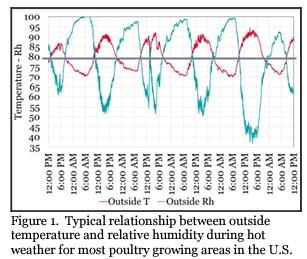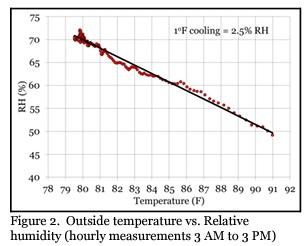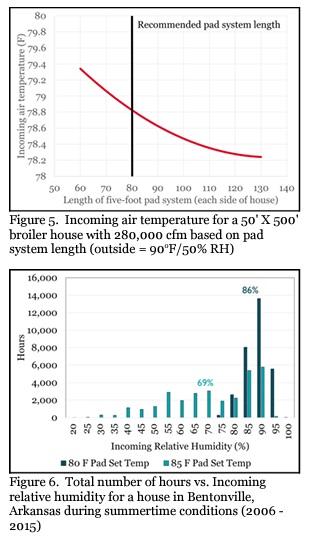15 Important Evaporative Cooling Principles
Published: December 1, 2023
By: Michael Czarick, Brian Fairchild / Department of Poultry Science - University of Georgia.
Unlike many aspects of operating a tunnel-ventilated house during hot weather, the performance of an evaporative cooling pad system is relatively predictable. This is because there are well defined relationships between the cooling produced by a pad system and water usage, pad area, outside temperature/humidity, and water temperature. Since most evaporative cooling pads are essentially identical and the summertime conditions are fairly similar across most poultry growing areas of the U.S., there are a number of evaporative cooling system performance facts that will hold true for all poultry growers. Knowing these facts can make it easier to understand how best to operate pad systems during hot, humid weather:
• During the summer, whenever the outside temperature drops below 80°F, the relative humidity will rise above 80%. As a result, using evaporative cooling pads when the outside temperature is 80°F or lower will tend to produce little cooling and increase the humidity of the incoming air to near saturation (Figure 1).

• The temperature of the water circulating over the pads has essentially no effect on the cooling produced by a pad system. In fact, circulating 30 degree cooler water over a pad (i.e., 45°F Vs. 75°F) will increase the cooling produced by a pad by less than one degree.
• The typical pad system is capable of circulating roughly ten times the amount of water over the pads than will evaporate from the pads. The primary purposes of running this volume of water over a pad are to keep it clean and limit the buildup of minerals on the surface of the pad. Operating a pad system using an interval timer will tend to increase the rate at which minerals build up on pad surfaces.
• Since pads are producing cooling through the evaporation of water, it is impossible to increase the cooling produced by a pad system without increasing the humidity of the incoming air.
• For every one degree of cooling produced by a pad system, the relative humidity will increase approximately 2.5°F (Figure 2).

• On the typical summer day, for every 20°F increase in outside temperature, the relative humidity of the air will be roughly cut in half (Figure 1).
• During the summer the outside relative humidity will tend to increase to between 90 and 100% at night (Figure 1).
• Once wetted, the typical evaporative cooling pad will tend to produce the same level of cooling for approximately ten minutes (Figure 3).
• It typically takes between 30 and 45 minutes for a pad to fully dry after the pump shuts off (Figure 3).

• A one-foot section of five-foot tall paper pad is capable of absorbing 0.6 gallons of water.
• Average evaporative cooling pad system water usage is typically between 2 to 3 gals/min per 100,000 cfm of operating tunnel fan capacity. Peak water usage is typically between 6 to 7 gals/min per 100,000 cfm of operating tunnel fan capacity (Figure 4).
• Increasing pad area by 25% over what is typically recommended will increase the cooling of the incoming air by less than one degree (outside 90°F/50%) (Figure 5).
• Setting pads to operate at 80°F as opposed to 85°F will tend to result in an increase in house relative humidity of approximately 15% (Figure 6).

• The average daily relative humidity in a broiler house during the last couple weeks of a summertime flock is typically between 80% and 95%.
This article was originally published in Poultry Housing Tips, Volume 35, Number 5, 2023. University of Georgia, College of Agricultural and Environmental Sciences Cooperative Extension (https://www.poultryventilation.com/).
Related topics:
Related Questions
What factors contribute to the predictability of an evaporative cooling pad system's performance?
Unlike many aspects of operating a tunnel-ventilated house during hot weather, the performance of an evaporative cooling pad system is relatively predictable. This is because there are well defined relationships between the cooling produced by a pad system and water usage, pad area, outside temperature/humidity, and water temperature.
How does the outside temperature affect the effectiveness of evaporative cooling pads?
During the summer, whenever the outside temperature drops below 80°F, the relative humidity will rise above 80%. As a result, using evaporative cooling pads when the outside temperature is 80°F or lower will tend to produce little cooling and increase the humidity of the incoming air to near saturation (Figure 1).
What is the impact of water temperature on the cooling produced by a pad system?
The temperature of the water circulating over the pads has essentially no effect on the cooling produced by a pad system. In fact, circulating 30 degree cooler water over a pad (i.e., 45°F Vs. 75°F) will increase the cooling produced by a pad by less than one degree.
What is the typical average daily relative humidity in a broiler house during the last couple weeks of a summertime flock?
The average daily relative humidity in a broiler house during the last couple weeks of a summertime flock is typically between 80% and 95%.
Authors:
University of Georgia
University of Georgia
Recommend
Comment
Share

Would you like to discuss another topic? Create a new post to engage with experts in the community.









.jpg&w=3840&q=75)